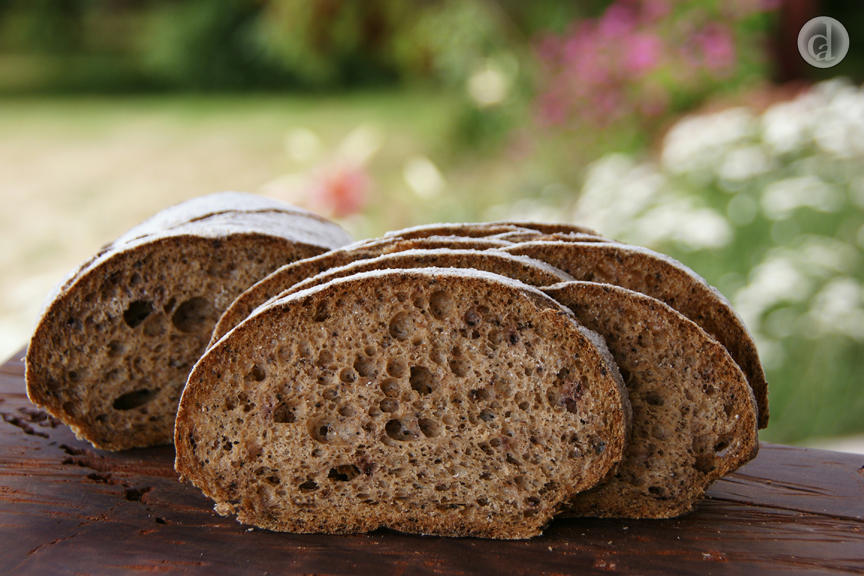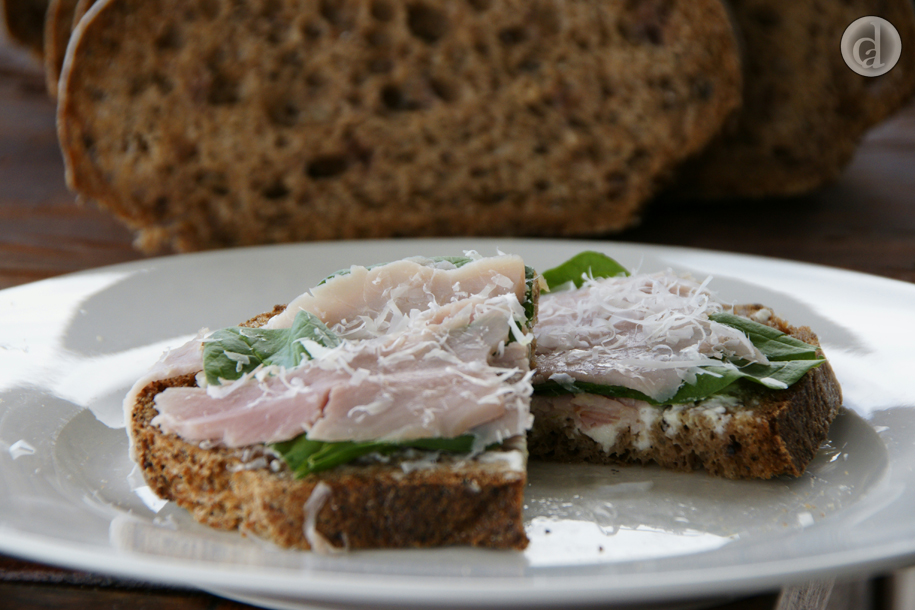
This sourdough recipe uses a 'wild' sourdough culture.
This recipe was designed specifically to be made with Bakers' Magic gluten free flour. The finished baked product will not be the same if you use another gluten free flour and you will need to adjust the recipe, particularly if the flour you're using contains rice flour.
Sourdough Starter
50 g of previous days leaven
50 g Bakers' Magic Gluten free flour
100 g Lukewarm water
~1.5 tsp Sugar (of some type)
or
50 - 70 g Roasted sweet potato
or
sugar + sweet potato - I usually add both
The remaining 150 g of the previous days leaven I either use to make bread (below) or put it on the humus heap.
I'm not gentle when it comes to mixing the starter - I find the easiest way to mix is with a stab blender. It's quick & gets the lumps out.
Sugar - your starter will need a sugar source (the simplest one is glucose powder). Sugar comes in various forms for example grated apple, roasted pumpkin, roasted sweet potato, honey or simpler versions table sugar, raw sugar, molasses. We want to add the Goldilocks amount of sugar to our culture. Too little you will starve your starter, too much & you will kill it, just the right amount & your starter will grow happily.
Adding the Goldilocks amount of sugar - Unfortunately I can't say what that amount is for your culture. For Arthur, my starter/leaven/culture, I know I haven't added enough food when I let the starter grow for ~6 hours (it has doubled in size) I swirl it back down & it doesn't grow again.
Roasted sweet potato - I usually bake it whole for 1 - 1.5 hours (depending on the size). I blend it with a food processor & freeze it in ice cube trays. Two of my roasted sweet potato ice cubes weigh ~70 g. I've fed my culture on one ice cube of sweet potato however the culture is not as active. The water content of the roasted sweet potato will vary & may affect the final shape of your loaf.
Ingredients
400 g Bakers' Magic Gluten free flour
1.5 - 2 tsp Salt
25 g Brown sugar
2 tsp Wattle seed powder
10 g Freshly ground pepperberries
150 g Sourdough starter (leaven)
10 g Psyllium husk powder or psyllium husk
50 g Oil (I use Rice bran)
400 g - 425 g Warm water
Psyllium husk - 10 - 15 g can be used.
Water - the amount of water added will affect the shape of the loaf.

 Method
Method
Prepare your banneton(s) (or line the banneton with a clean chux or thin soft linen tea towel) - I have used 2 oblong bannetons lined with a clean chux or a large round banneton. If using a serving/pasta bowl you want to coat the inside of the bowl with flour/sesame seeds/buckwheat flakes to stop the dough from sticking to the bowl. Lightly oil or spray a fine mist of water on the inside of the bowl then dust with sifted flour (or sesame seeds/buckwheat flakes). Lightly spray another coat of oil or water then dust with sifted flour (or sesame seeds/buckwheat flakes).
Add all ingredients to the bowl of a stand mixer. Using the flat beater combine the mix until a uniform consistency is achieved. You may need to stop the mixer and scrap down the sides.
Divide the dough (if using 2 oblong bannetons) & transfer to the proving basket(s) or your prepared bowl(s). Let the dough prove for 3-5 hours in a warm moist environment. You don't want the top of the dough drying out. I usually put the proving basket into a large ziplock plastic bag & seal it. The actual proving time will depend on many factors particularly how active your sourdough starter (leaven) is. I usually make the dough in the evening, prove the dough for at least 2 hours in a warm spot (in the ziplock bag) and then transfer it to the fridge overnight. The next morning I will bake the bread - fresh bread in the morning :).
Before putting it in the oven ensure that the dough has risen ~1.5X.
Turn your oven on to 180 - 200o C. Setting the oven at 180o C will result in a thinner crust than bread baked at 200o C. A thicker crust will hold the shape of the bread better when the bread has cooled.
Line a baking tray with baking paper. Gently take the dough out of the basket/bowl & place onto the baking paper. Optional - dust the top of the dough with some maize starch (cornflour from maize/corn) & then using a sharp knife make slashes on the top of the dough.
Bake at 180 - 200o C for ~50 mins if baking 2 oblong loaves or ~1 1/4 hrs if baking a single round cob. The time will vary depending on the individual oven. If your oven has a hot spot turn the bread halfway through baking. Baking the bread for longer will result in a wonderfully crusty bread.
Take out of the oven & cool the bread on a cooling rack. Ensure the bread is sufficiently cooled before cutting into it.
When the bread is more than a day old I refresh the bread by sprinkling it with a little water & putting it back in the oven for ~20 mins at 180o C.
Simply enjoy!
